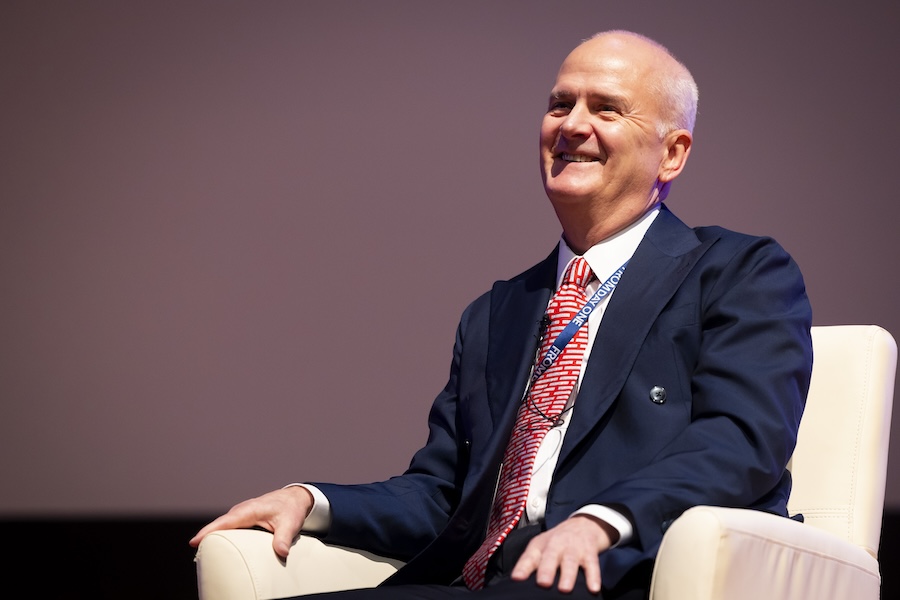Workspace Leadership: The Powerful Role of Place in Worker Well-Being and Productivity


“Everybody's familiar with the traditional ways of keeping employees happy, right?” KHOU 11 anchor and reporter Shern-Min Chow inquired. “Their salary, bonuses, benefits, health insurance. But you have some pretty interesting ideas just about our workspace in general.”
“Any place we go, whether that is a sacred space, a shared space, or a private space – there are certain features that affect our needs in the workplace,” responded Dr. Alan Witt during a fireside chat at From Day One’s Houston conference.
Witt, who regularly works with environmental psychologists and architects, provided the audience with profound insight into the psychological and physiological impact of the physical place of work on employee satisfaction and productivity.
From the colors of the wallpaper to the presence of real (or fake) plants – every detail plays a role in cultivating a particular mood and atmosphere that can improve or hinder employee satisfaction, development, and engagement, he says.
As a professor of public affairs, management, leadership, and psychology at the Bauer College of Business, Witt shared the impact of the workplace on engagement, development, and employee mental well-being.
Servant Leadership: Surveying Environments for Solutions
Servant leadership is a holistic approach to creating a productive workplace. It is a methodology that measures success through employee well-being and development. Servant leaders survey what areas of the workplace impact employee health and productivity to make sustainable improvements.
“It's a mindset that a lot of us focused on productivity and achievement don't really have,” Witt said. “But if you treat people as the customer, they will generally respond.”

Traditional leadership measures success based on adherence to employee performance plans, quantified with data analysis. Servant leadership assesses the quality of the employee experience as an indication of success.
Servant leaders also assess the physical environment, company culture, and their respective influences on well-being, diversity, equity, and inclusion to identify problems and create solutions to an individual’s personal and professional growth.
By replicating the customer-first experience with employees, servant leaders can identify areas of improvement in the physical environment that may boost engagement in ways that traditional leadership and performance plans miss.
Physical Elements Conducive to Workplace Performance
Chow and Witt identified several physical elements of a supportive workplace. Crafting an efficient workplace involves considering human psychological and physiological complexities within specific environments.
For example, Chow, a news anchor at KHOU-TV, asks Witt for his perspective on the TV channel’s recent move to a new facility without permanent desks. People in the workplace may not like that because it obfuscates their identities with no individually designated spaces, says Witt.
“People like to have their space and have their stuff, and they want to make it their own so that they can identify with it and people will recognize it as theirs,” Witt said.
He cites UC Berkeley’s Employee Engagement Model, where autonomy and belonging are among the top 12 conscious and subconscious psychological needs that, once met, help improve employee motivation. Chow confirmed this analysis creates more efficiency. After finding the stand-up desk she liked, she remained at the same one for three years.
Witt recalls when he asked a colleague what color he should use during a house renovation: “And so I called and said, ‘Please tell me what colors to choose.’ She said, ‘What do you want to experience?’ That's the key phrase that HR folks think about.”
When cultivating an engaging workplace, elements that create positive physiological responses are the most sustainable. From a psychological perspective, Witt provided several examples of strategizing a workspace supporting employee mental well-being like assessing indoor air quality for mold, airflow, and temperature control. Buildings made of up to no more than 50% light wood rather than dark wood elicit a positive physiological impact and blue, green, and white encourage more focus and positive social engagement and interactions, says Witt.
The unique set-up of a workplace environment plays a critical role in creating an atmosphere and behavioral dynamic that influences employees to feel more belonging and at ease or isolated and restricted.
When it comes to cost-efficient solutions, Witt believes more studies are needed to determine the extent to which individuals can have control over their spaces in the workplace to support their needs without disrupting the workflow of other employees.
Stephanie Reed is a freelance news, marketing, and content writer. Much of her work features small business owners throughout diverse industries. She is passionate about promoting small, ethical, and eco-conscious businesses.
The From Day One Newsletter is a monthly roundup of articles, features, and editorials on innovative ways for companies to forge stronger relationships with their employees, customers, and communities.